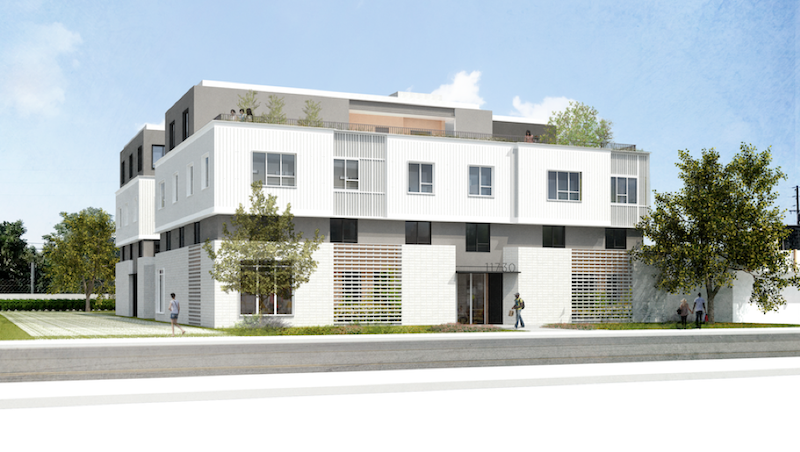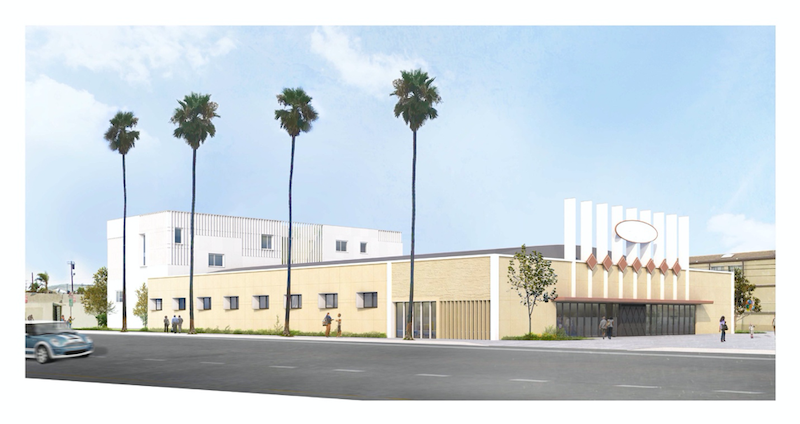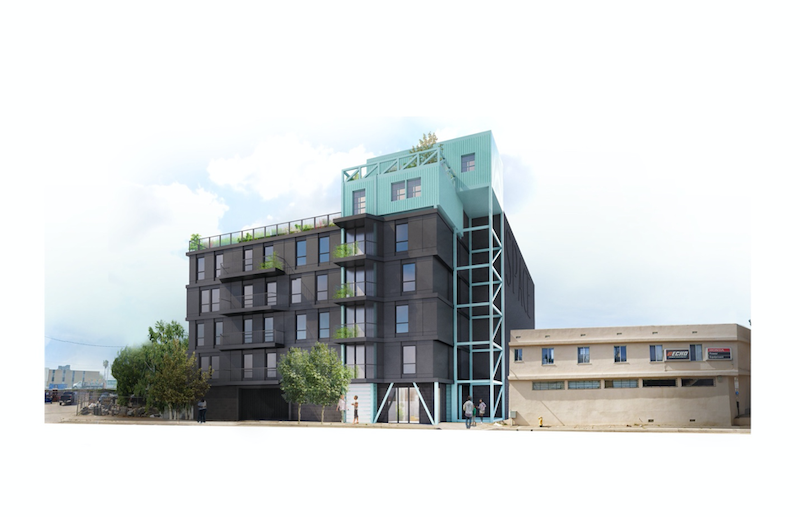With Southern California’s housing crisis in full throttle, the rush for buildable land continues. Prime lots—those in great neighborhoods with zoning and physical characteristics making them conducive to new residential projects—get snapped up by market-rate developers at high prices, justified in the end by high rents. Affordable housing, often being developed by nonprofits, can’t compete in that world and must seek out available sites that are in less pricey neighborhoods and that may have compromised physical characteristics.
These are the misfit parcels: the leftover triangles, the vacant weedy lots in industrial or commercial areas that are waiting for residential pioneers, the sites where preexisting restrictions ward off risk-adverse market-rate developers.
It is on these odd, often undervalued lots that reinvention and the uncovering of possibility through design can occur most dramatically. Pioneers of these real estate frontiers look for opportunities to create something new where little existed before and, when done well, existing context is understood, respected, and responded to through design.
Over the past year, the authors have tackled a number of these odd sites for affordable housing developers, with the hope that after the pro formas are complete, the cost estimates are ballparked, and land offers are in, that some deals will stick and lead to actual built projects. The goal is to have projects that not only pencil, but that also reveal something essential about their sites to inform design and create livable environments.
Following are six diverse affordable housing projects—four of which are progressing toward further development in 2021—located throughout the LA basin that the KFA team has explored.
ECHO PARK, LA: NEW PERMANENT SUPPORTIVE HOUSING
Over the past two decades, Echo Park has seen its real estate fortunes rise as spillover from Silver Lake, and the ascent of downtown LA has put it squarely in the crosshairs of gentrification. It’s a hilly neighborhood full of character and characters, its diversity ranging from old school Latino culture to yuccies in rehabbed houses with skyscraper views. The prime parcels in Echo Park were bought and sold long ago, but there remain many odd parcels wedged along Sunset Boulevard as it twists through the hills and faded commercial districts.
This project, which is scheduled to start construction in late 2021, received its entitlements for 64 units of permanent supportive housing earlier this year. It is an irregular commercially zoned parcel, currently a parking lot, that faces the back wall of a grocery store across the street. On one side is a corner mini mall, and the edge of an older multifamily residential neighborhood on the other side, ascending a hill. The street is a block off Sunset and features a bike lane and a mix of uses, including a large school complex on the next block.

Echo Park, LA. Rendering: Livia Cavallo, KFA Architecture
The architectural response of the project was to recognize the commercial nature of the street, but also to provide a scale and warmth conducive to housing. The L-shaped building’s primary open space faces the residential neighborhood to the northwest, significantly reducing the massing and limiting shadowing on the properties adjacent. Also important to the trend-conscious neighborhood, expressed in public meetings during entitlements, was to have a contemporary architectural sensibility.
HAYES NEIGHBORHOOD, EL MONTE: LOOK CLOSELY TO DISCOVER ITS HIDDEN IDENTITY
Ramona Boulevard is not a residential street. In its beginnings extending out from downtown LA, it was the city’s first expressway (sorry, Arroyo Seco), before heading into the San Gabriel Valley as a major thoroughfare flanking the Pacific Electric streetcar line feeding points east. With the demise of the railway, the PE right-of-way through El Monte was sold off and Ramona Boulevard became just another arterial commercial street serving the freeways and suburbs that exploded over the San Gabriel Valley landscape in the mid-20th century. It is a wide four-lane street, home to parking lots and nondescript one- and two-story buildings: motels, fast-food joints, and the myriad businesses that serve the nearby single-family neighborhoods.
It is in this context that a vacant site became available to develop as affordable housing in partnership with the City of El Monte. As Cavallo, the Lead Designer, noted, “I am from Rome, whose identity is well known and easy to understand. At places like Ramona Boulevard, it’s tempting to say that there is no identity or context, but when you look more closely, there is tons of identity.”

Hayes El Monte. Rendering: Livia Cavallo, KFA Architecture
The 49-unit, permanent supportive housing design looks to the horizontality prevalent in the surrounding built environment. Unlike the condominiums across the street, it seeks to avoid turning its back on the boulevard, but rather to acknowledge its place and create a series of porous transitions from the boulevard to residential uses. The project is slated to start construction in Q3/2021.
PICO, SANTA MONICA: SAVING A CULTURAL ICON
Japanese neighborhoods across California suffered immensely during World War II when many of their residents were sent to internment camps. The Pico neighborhood in Santa Monica was one of the few that was able to reestablish itself after the war. In 1957 the Japanese community there built a modest social center, Nikkei Hall, on Michigan Avenue. Over the years, however, the community hall fell into disuse and was eventually sold. In 2018 the City of Santa Monica landmarked the structure for its cultural importance.
This project was designed to occupy the large parking lot that surrounds the small one-story building. Its strict design review, landmarks protection, and lengthy approval process rendered the parcel toxic to market-rate developers. It took a nonprofit organization - EAH Housing - and incentives from the city to make a project feasible for affordable housing.
The proposed design rehabilitates Nikkei Hall as a community room and manager’s unit, and surrounds it with a permanent supportive housing building that seeks to respect the landmarked structure with subtle references to its modest mid-century style and Japanese cultural roots. Once lost in a sea of parking, the landmarked building is enhanced and celebrated because of the new building’s design deference to it.

Pico Santa Monica. Rendering: Livia Cavallo, KFA Architecture
“I think the Japanese community center will get more of the attention it deserves with a larger building surrounding it, rather in the middle of a parking lot,” said Cavallo. Having recently received is entitlement approvals from the city, the project is scheduled to start construction in the fall of 2021.
The project received unanimous approval from the Landmarks Commission in August 2020 and is now in design development. It is scheduled to start construction in the fall of 2021.
WILMINGTON: SPACE AGE DESIGN FOR THE 21ST CENTURY
Wilmington was its own city until 1909, when it was annexed by Los Angeles and eventually absorbed into the fabric of the metropolis by post-WWII development that swept southward toward Orange County. Wilmington is a port town, less than a mile from the sprawling Port of Los Angeles, and it still sports a solid old-school downtown and a concentrated street grid.
The site for this permanent supportive housing project was built out as a grocery store in the early 1950s. The existing building features some vintage Googie styling in the Space Age fins over the entry. As grocery stores left the city, it was turned into a dollar store; it has been vacant for the past eight years. The zoning for the parcel, amended in the 1990s, overlays the site with reduced density and suburban design guidelines, making it more difficult for a market-rate developer to achieve any significant return on investment.
The city’s recent Permanent Supportive Housing ordinance has opened the door to affordable housing at a density worth pursuing and incentives that take some of the sting out of the 1990s guidelines. The project, proposed by a nonprofit, features 54 rental units in studios and one-bedrooms.

Wilmington. Rendering: Livia Cavallo, KFA Architecture
What sets the project apart is the adaptive reuse of the existing building into 16 units by peeling back part of the roofing on the bowstring trusses and creating an interior courtyard within the shell of the grocery store. A narrow four-story addition at the rear houses the remaining units. The project is in the earliest stages of design and feasibility.
So, four "misfit" affordable housing projects that will, Covid willing, come to fruition next year. Unfortunately, two promising odd-lot opportunities—in South Los Angeles and Inglewood—have failed to move ahead.
VERMONT SQUARE, SOUTH LA: RETHINKING AN URBAN CURIOSITY
Before there was zoning, cities developed largely without restriction. In the early 1900s the single-family neighborhood of Vermont Square sprang up along South Hoover Street just south of the Coliseum, with some light commercial along Hoover and Vermont Avenue. The exception was a five-story warehouse with a vaguely classical facade design that was built in the middle of the district. More than 100 years later it remains the tallest building in the neighborhood by far—an urban curiosity.
Earlier this year, a nonprofit proposed to adapt the structure, which had been occupied by a leather clothing manufacturer, for permanent supportive housing—24 units in the existing building, another 40 units of new construction in the surrounding parking lot. The design created open space at the rear, and sought to dialog with the rigidness of the existing architecture in a playful way, but with the same basic building type. Unfortunately, the deal to acquire the site fell through and it was sold to another party.

Vermont Square. Photo: KFA Architecture
FAIRVIEW HEIGHTS, INGLEWOOD: A TOD IN THE MAKING
Metro’s new Crenshaw Line is slated to open later this year. It cuts through a number of old-school, established neighborhoods, such as leafy Fairview Heights in the north end of Inglewood. Transit-oriented design is the objective of the specific plans the City of Inglewood has implemented along the new rail lines. Florence Avenue and the rail line itself cut diagonals across the choppy grid of the area, creating problematic irregular parcels, many of which are isolated by uncrossable rights-of-way, industrial uses, and the enormous Edward Vincent Park and Inglewood Park Cemetery.

Fairview Heights. Rendering: Livia Cavallo, KFA Architecture
Here, at an acutely triangular site directly adjacent to the new Fairview Heights Station, the design team looked to the existing industrial context for clues to inform the architecture. Straightforward massing defines the bulk of the building, with an addition of a robin’s-egg blue structure that points up the building’s entry, vertical circulation core, and top-floor community room.
“The blue color was inspired by the patina of port structures I saw along the harbor in New York, and I thought it worked really well here in this semi-industrial area,” said Lead Designer Livia Cavallo. The project has not moved forward, and the land is still for sale.
AS CITIES LIKE LOS ANGELES BUMP UP against their outward growth boundaries, making the most of problematic, underdeveloped land closer in has become the next frontier to accommodate housing. Affordable housing, being less dependent on locational market forces, has the unique advantage of being able to explore the most challenging of these "misfit parcels" to create livable environments that respond to their context.
ABOUT THE AUTHORS: LIVIA CAVALLO AND JOHN ARNOLD
Livia Cavallo earned her Master of Architecture from Sapienza University, Rome, Italy, having also studied in Germany at the Technical University of Munich as an Erasmus student. After obtaining her Italian architectural license and gaining two years of professional experience in Rome, she moved to Los Angeles to join KFA, where she brings her expertise in design and construction, as well as the renovation of public buildings, as a Lead Designer.
Since joining KFA in 1999, John Arnold, AIA, has cultivated deep experience in multifamily affordable and market-rate housing of all types: micro-units, lofts, senior housing, mixed-use, adaptive reuse, and condominiums, as well as hotels. Arnold volunteers in his South LA neighborhood and with Habitat for Humanity; in 2019, he was elected to the board of Abode Communities, a statewide nonprofit affordable housing provider. He earned a BS in Environmental Design from the University of Massachusetts and a Master of Architecture from the University of Washington. He was named a Partner of the firm in 2016.
Related Stories
| Mar 17, 2011
Perkins Eastman launches The Green House prototype design package
Design and architecture firm Perkins Eastman is pleased to join The Green House project and NCB Capital Impact in announcing the launch of The Green House Prototype Design Package. The Prototype will help providers develop small home senior living communities with greater efficiency and cost savings—all to the standards of care developed by The Green House project.
| Mar 11, 2011
Renovation energizes retirement community in Massachusetts
The 12-year-old Edgewood Retirement Community in Andover, Mass., underwent a major 40,000-sf expansion and renovation that added 60 patient care beds in the long-term care unit, a new 17,000-sf, 40-bed cognitive impairment unit, and an 80-seat informal dining bistro.
| Mar 11, 2011
Mixed-income retirement community in Maryland based on holistic care
The Green House Residences at Stadium Place in Waverly, Md., is a five-story, 40,600-sf, mixed-income retirement community based on a holistic continuum of care concept developed by Dr. Bill Thomas. Each of the four residential floors houses a self-contained home for 12 residents that includes 12 bedrooms/baths organized around a common living/social area called the “hearth,” which includes a kitchen, living room with fireplace, and dining area.
| Mar 11, 2011
Texas A&M mixed-use community will focus on green living
HOK, Realty Appreciation, and Texas A&M University are working on the Urban Living Laboratory, a 1.2-million-sf mixed-use project owned by the university. The five-phase, live-work-play project will include offices, retail, multifamily apartments, and two hotels.
| Mar 1, 2011
How to make rentals more attractive as the American dream evolves, adapts
Roger K. Lewis, architect and professor emeritus of architecture at the University of Maryland, writes in the Washington Post about the rising market demand for rental housing and how Building Teams can make these properties a desirable choice for consumer, not just an economically prudent and necessary one.
| Feb 15, 2011
New Orleans' rebuilt public housing architecture gets mixed reviews
The architecture of New Orleans’ new public housing is awash with optimism about how urban-design will improve residents' lives—but the changes are based on the idealism of an earlier era that’s being erased and revised.
| Feb 11, 2011
Chicago high-rise mixes condos with classrooms for Art Institute students
The Legacy at Millennium Park is a 72-story, mixed-use complex that rises high above Chicago’s Michigan Avenue. The glass tower, designed by Solomon Cordwell Buenz, is mostly residential, but also includes 41,000 sf of classroom space for the School of the Art Institute of Chicago and another 7,400 sf of retail space. The building’s 355 one-, two-, three-, and four-bedroom condominiums range from 875 sf to 9,300 sf, and there are seven levels of parking. Sky patios on the 15th, 42nd, and 60th floors give owners outdoor access and views of Lake Michigan.
| Feb 11, 2011
Sustainable community center to serve Angelinos in need
Harbor Interfaith Services, a nonprofit serving the homeless and working poor in the Harbor Area and South Bay communities of Los Angeles, engaged Withee Malcolm Architects to design a new 15,000-sf family resource center. The architects, who are working pro bono for the initial phase, created a family-centered design that consolidates all programs into a single building. The new three-story space will house a resource center, food pantry, nursery and pre-school, and administrative offices, plus indoor and outdoor play spaces and underground parking. The building’s scale and setbacks will help it blend with its residential neighbors, while its low-flow fixtures, low-VOC and recycled materials, and energy-efficient mechanical equipment and appliances will help it earn LEED certification.
| Feb 11, 2011
Apartment complex caters to University of Minnesota students
Twin Cities firm Elness Swenson Graham Architects designed the new Stadium Village Flats, in the University of Minnesota’s East Bank Campus, with students in mind. The $30 million, six-story residential/retail complex will include 120 furnished apartments with fitness rooms and lounges on each floor. More than 5,000 sf of first-floor retail space and two levels of below-ground parking will complete the complex. Opus AE Group Inc., based in Minneapolis, will provide structural engineering services.
| Jan 27, 2011
Perkins Eastman's report on senior housing signals a changing market
Top international design and architecture firm Perkins Eastman is pleased to announce that the Perkins Eastman Research Collaborative recently completed the “Design for Aging Review 10 Insights and Innovations: The State of Senior Housing” study for the American Institute of Architects (AIA). The results of the comprehensive study reflect the changing demands and emerging concepts that are re-shaping today’s senior living industry.














